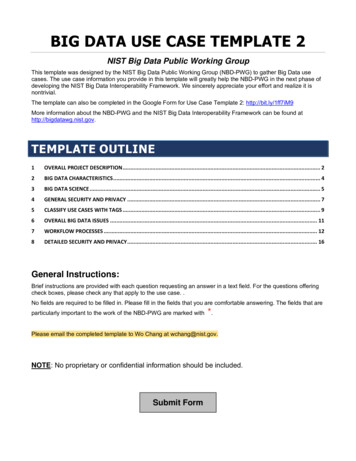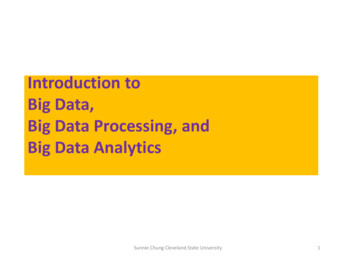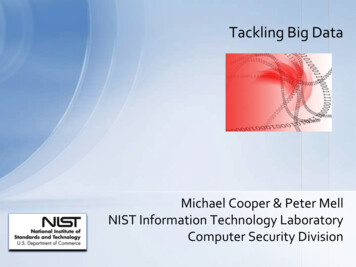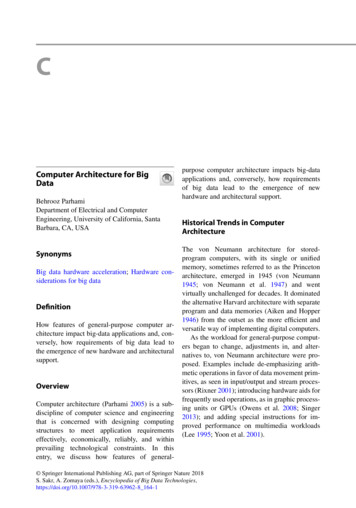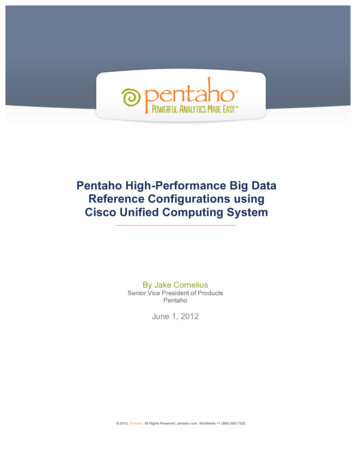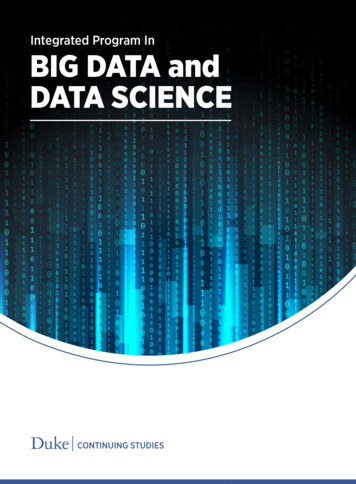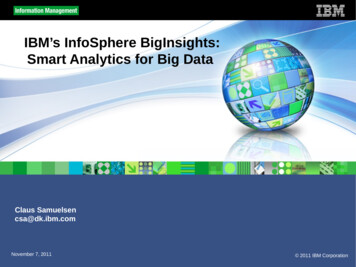
Transcription
Issues in Informing Science and Information TechnologyVolume 12, 2015Cite as: Rossi, R., & Hirama, K. (2015). Characterizing Big Data Management. Issues in Informing Science andInformation Technology, 12, 165-180. Retrieved from dfCharacterizing Big Data ManagementRogério Rossi & Kechi HiramaUniversity of São Paulo, São Paulo, Brazilrossirogerio@hotmail.com kechi.hirama@usp.brAbstractBig data management is a reality for an increasing number of organizations in many areas andrepresents a set of challenges involving big data modeling, storage and retrieval, analysis andvisualization. However, technological resources, people and processes are crucial to facilitate themanagement of big data in any kind of organization, allowing information and knowledge from alarge volume of data to support decision-making. Big data management can be supported by thesethree dimensions: technology, people and processes. Hence, this article discusses thesedimensions: the technological dimension that is related to storage, analytics and visualization ofbig data; the human aspects of big data; and, in addition, the process management dimension thatinvolves in a technological and business approach the aspects of big data management.Keywords: Big Data, Big Data Management, Big Data Challenges, Big Data Analytics,Decision-Making.IntroductionBig data refers to the idea that a vast amount of data cannot be treated, processed and analyzed ina simplified way. To Bughin, Chui & Manyika (2010), nowadays, the data are identified inseveral environments in volumes never seen before, doubling every 18 months as a result of manytypes of databases as proprietary databases, databases derived from Web communities and fromother types of intelligent data assets.Manyika et al. (2011) consider that big data refers to datasets whose size goes beyond typicaldatabases that can be created, stored, managed and analyzed by existing tools; they also considerthe need of creating new technologies for managing big data. It can be seen that several areascurrently have data volumes from dozens of terabytes to multiple petabytes (thousands ofterabytes).Fisher, DeLine, Czerwinski & Drucker (2012), however, consider that most often big data refer tothe conception that the volume of data cannot be treated, processed and analyzed in a simplifiedway, requiring much more robust technologies, techniques and people with new skills formanaging these large data sets.Material published as part of this publication, either on-line orin print, is copyrighted by the Informing Science Institute.Permission to make digital or paper copy of part or all of theseworks for personal or classroom use is granted without feeprovided that the copies are not made or distributed for profitor commercial advantage AND that copies 1) bear this noticein full and 2) give the full citation on the first page. It ispermissible to abstract these works so long as credit is given.To copy in all other cases or to republish or to post on a serveror to redistribute to lists requires specific permission andpayment of a fee. Contact Publisher@InformingScience.org torequest redistribution permission.As can be seen in Borkar, Carey & Li(2012b), actions related to big data reachvarious sectors for specific purposes,such as: 1) governments and businesstracking contents of several Web socialnetworks to perform sentiment analysis;2) public sector organizationsmonitoring health research and variousnetworks to evaluate and to treatepidemics; 3) commercial marketingEditor: Eli Cohen
Characterizing Big Data Managementevaluating the actions of people through social networks in order to understand the behavior oftheir potential customers.Borkar, Carey & Li (2012b) argue that the support being offered to organizations consideringdata-intensive computing, research and analysis, as well as the ability to store data are generatingsignificant challenges to big data management.For Chen, Chiang & Storey (2012) the big data era has reached several sectors, from governmentand e-commerce to healthcare organizations. The abundance of data in critical and high socialimpact sectors requires discussions on data and analytics characteristics. There are someexamples of potential areas that deal with these vast amounts of data, such as 1) e-commerce andmarket intelligence, 2) e-government, 3) science, 4) health insurance, and 5) security.Grover (2014) points out that the ability to extract knowledge from vast amounts of data that arestored providing opportunities for big data systems can be used and applied to many sectors, suchas 1) healthcare, 2) mobile networks, 3) video surveillance, 4) media and entertainment, 5) lifesciences, 6) transportation, and 7) study environment.Russom (2013) considers that sensors spread throughout the world produce outrageous amountsof machine data, highlighting the challenges of capturing and managing these vast amounts ofdata that are generated continuously in real time and in multi-structured format.For any of the sectors, some issues must be considered to achieve satisfactory results from bigdata management. Manyika et al. (2011) consider the following factors as relevant to extract thebest results with of big data management: 1) data policies definition, 2) specific technology andtechniques; 3) organizational change and talents; 4) data access, and 5) infrastructure.Considering the application of big data by organizations of various industries the collection andstorage of data are observed to be held in proportions unimaginable in the past. Examples can beseen in Bughin, Chui & Manyika (2010), who present some results related to Facebook, which injust two years has quintupled its user database, reaching 500 million users; and Manyika et al.(2011) who point out that, if considering specifically 2010, it appears that global companiesexceeded seven exabytes (one exabyte corresponds to one million gigabytes) of data stored.However, Bughin, Chui & Manyika (2010) show that executives in different sectors arewondering about the difficulties to extract the best results from big data, enabling companies tocapitalize the best answers from the abundance of data and enabling them to better manageknowledge to provide capacity for decision-making.Russom (2013) considers some preliminary difficulties for managing big data: 1) groups ofpeople who are from business or technological areas but do not have adequate skills; 2)inadequate data management infrastructure; and 3) treatment of immature types of data fromdifferent sources, such as semi-structured or unstructured data."Data are flooding in at rates never seen before" as state Bughin, Chui & Manyika (2010, p.7);thus, the application and use of big data are increasingly and a vast amount of data with varyingstructures have been used by organizations of many sectors. These data are categorized byRussom (2013) as follow: 1) structured data; 2) complex data (hierarquical or legacy sources); 3)semi-structured data; 4) web-logs; 5) unstructured data; 6) social media data; and 7) machinegenerated data (sensors, RFID, devices).Thus, the ability to manage big data, i.e., a high volume of data with the extensive variety of datatypes that should provide rapid responses is a reality for the organizations that must handle withrelevant challenges of big data management as the dimensions related to people, technology, andprocess management.166
Rossi & HiramaThe characterization of big data management and the relationship with these three dimensionsbecome the purposes of this article, as regards: 1) highlighting the importance and purpose of bigdata management; 2) addressing and discussing specific needs involving big data management; 3)discussing several technological, human and process aspects related to big data management; and4) presenting the difficulties and challenges to analyze the vast amount of data and to visualizethe results.To meet the above objectives, this article is organized as follows: section two presents atheoretical development of big data management; section three considers some works that may berelated to this research that also treat the aspects and characteristics of big data management;section four discusses people, process, and technology dimensions involving big datamanagement; section five presents the difficulties and challenges to manage big data; and finally,section six presents the conclusion and proposals for future work.Theoretical Development of Big DataGlatt (2014) presents historical factors concerning the term big data, mentioning that this term hasbeen used since the completion of the 1880 Data Census in the United States. At that moment,with no technology or advanced techniques for data collection and organization, the vast amountof data took seven years to process and finally show results.Borkar, Carey & Li (2012b) go back to the 1970s to present separate consideration of the term bigdata, the word 'big' at that time, referring to megabytes, and 'big' over time came to meangigabytes, evolving to terabytes. Currently, the authors mention that this word related to the termbig data refers to petabytes and exabytes.Bedeley & Iyer (2014) suggest that the term big data was introduced in computing in 2005 todefine a large volume of data that traditional data management technologies were not able tomanage or to process due to their complexity and volume.While in the area of computing the term has been employed recently, researchers in other areasare presenting results since 2000. Accordingly to Chen, Chiang & Storey (2012) in a surveypointing to quote the keywords 'business intelligence' 'business analytics' and 'big data', theevolution of the latter is quite relevant given that in 2001 only one study was found referencingthe term, and in 2011, 95 were found using the specific term ‘big data’.Luzivan & Meirelles (2014) collaborate with researches into the evolution of the term big data inscientific reports presenting results that show that, in scientific journals, in 2010, 15 reports werefound employing this term, and in 2013, 380 scientific reports were found considering the sameterm.Bedeley & Iyer (2014) present results across top tier IS journals (journals that occupy the top spotaccording to the MIS journal rankings) allowing checking that in the field of business, only 16articles were identified mentioning the term big data.These results present a quantitative insight into the related research, although the results presentedby Bedeley & Iyer (2014) also propose a qualitative view of the technical and scientific reportsidentified. However, the results demonstrate the need for studies and research in the area, giventhat needs related to big data management are a reality for an increasing number of organizations.As states Gartner (2012), 85% of the companies’ infrastructure will be overloaded by big datauntil 2015. Moreover, as mentioned by Luzivan & Meirelles (2014), several authors showed alack of academic studies related to big data under broader and integrative analysis.According to the definition of the word 'big' from the term big data, Borkar, Carey & Li (2012b)mention that it varies over time, from megabytes (1970s) to exabytes (2014). For Luzivan &167
Characterizing Big Data ManagementMeirelles (2014), this word belongs to the term big data, and can be seen as a large volume ofdata in an individualized context and as small volume of data in another; or as large volume ofdata at a given observed moment and small at another. For Jacobs (2009, p. 40) “what makesmost big data big is repeated observations over time and/or space”.However, Demchenko, Laat & Membrey (2014) argue that 'big' is not specifically restricted to thevolume, but also refers to variables addressing variety, velocity, value, and veracity which makeup the Big Data 5V Properties.The expression, or the full term big data, presents diverse definitions observed in the recentscientific literature. Definitions identified for the term big data are verified in Manyika et al.(2011), in Russon (2013), among other scientific reports. However, this article presents adefinition proposed in a draft framework of the NIST (National Institute of Standards andTechnology) linked to the US Department of Commerce, which corresponds to: “Big dataconsists of extensive datasets, primarily in the characteristics of volume, velocity, and/or varietythat require a scalable architecture for efficient storage, manipulation, and analysis” (NIST,2014a, p. 5).Reflections on big data must be able to effectively meet business competitiveness and supportdecision-making, which should also be related to the information science and knowledgeengineering. Issues that have been considered by Turban, Aronson & Liang (2005) and Laudon &Laudon (2007) for a long time address the elements that integrate the application of informationmanagement and knowledge management to business. For Brynjolfsson & McAfee (2012), bigdata management is responsible for seeking to glean intelligence from data and for translating thatinto business advantage.The considerations regarding the definition of big data in a practical and effective manner withinan organization may consider the ‘Big Data 5V properties’ presented by Demchenko, Laat &Membrey (2014). This is a way to set the big data in an organization, considering the '5Vproperties’ that represent: 1) volume, 2) variety, 3) velocity, 4) value, and 5) veracity. It isessential to characterize the environment that can first consider the combination of volume andvariety of data to be processed to generate intelligence and competitive advantage for thebusiness.The definition and clarity of the aspects involving the scenario facing big data enable theorganization to align with the specific technologies and techniques that are restricted to big data,and require that it has better control of processes and human resources with specific skills to meetneeds related to big data management. Brynjolfsson & McAfee (2012) show that businessexecutives are questioning whether big data is another way to say analytics. This makes explicitthe need to define and to clarify the particular aspects for managing big data in a consistent andreal way and to meet the expectations.Currently, organizations are not worried with the question of the need of big data, because it ismore than the necessity, it’s a reality that should be managed. Big data reflects existing scenariosin multiple-sector organizations. There is a vast amount of data with varied structures, as semistructured, unstructured or multi-structured data, and there is a necessity to provide quickresponses, with the implementation of effective mechanisms for big data management,considering new technologies, organization and process changes, and right people.Related Works on Big Data ManagementThe current situation regarding big data management presents diverse studies involvingtechnological issues, issues dealing with data management, data analysis; there are also studiesthat link big data to business intelligence or to other consolidated information technology168
Rossi & Hiramaapproaches. Usually related studies to manage big data propose two approaches, one that stronglyaddresses the technological and technical issues to institutionalize and to maintain aninfrastructure that considers big data and another that seeks to meet the business goals.Big data management in this research is not restricted to management based exclusively oninformation technology, but also considers the involvement of human resources as well as theorganizational processes for managing big data.For Russom (2013), there is a difference between managing big data at a technological level andmanage big data in order to support successful business objectives. Hence, the author proposestwo relevant questions regarding big data management that correspond to: 1) how effectivelydoes an organization have the technological capacity to manage big data?; and, 2) does themanagement of big data have the ability to support the business goals?In fact, information engineering and knowledge management, according to Turban, Aronson &Liang (2005), collaborate with the organizations, increasing their capacity of competitiveintelligence and decision-making. In this sense, for business objectives, managing big databecomes essential to provide favorable results from the vast amount of data.Russom (2013) presents evidence from a survey on a number of North American, European andAsian companies showing that only 3% of the organizations were considered to be at a relativelymature state to manage big data. Most of the organizations participating in the survey (37%)reported to be arguing about it without commitments with the institutionalization of big data.Regarding the expectation of when these organizations expect to have big data in production, themajority (22%) believes that only in three years or more, but 10% of the respondents expect toimplement the management of big data within 6 months.A case study of the banking industry presented by Bedeley & Iyer (2014) discloses that this sectorhas huge volume of data being generated and processed continuously given to issues related tohigh competitiveness of the sector and the significant increase in customer database. Other issuesthat lead to the increased volume of data for the sector are mobile banking and e-banking. Thisrequires that data capture, storage, processing, and analysis strategies, i.e., managing big datashould be supported by high technology to provide the best results.Brynjolfsson & McAfee (2012) suggest that organizations to manage big data should particularlyconsider five areas: 1) leadership, since the era of big data means not just more data, but theability to extract results; 2) talent management, considering that the most crucial are the datascientists and professionals with skills to deal with the vast volume of data, organizing large datasets that are not only in structured format; 3) technology, as an important component of thestrategy for big data; although the available technology has improved significantly for managingbig data, it should be considered novel for many IT departments and integration should beperformed; 4) decision-making, reflects the need to maximize cross-functional cooperationbetween people who manage the data and the people who use them, people who understandbusiness problems must be close to certain data and with people who know effective techniquesfor extracting the best results; and, 5) company culture, a data-driven organization should cease tobe guided solely by hunches and stop using the hippo traditional approaches.Implementation strategies of big data management actions should be considered for organizationsand can be checked at NIST (2014b) and Brynjolfsson & McAfee (2012). NIST (2014b)considers four steps that favor the strategic assessment of big data management: 1) identifyingand including stakeholders, 2) identifying potential roadblocks, 3) defining achievable goals, and4) defining ‘finished’ and ‘success’ at the beginning of the project.For Brynjolfsson & McAfee (2012), some steps can guide the use and application of big datamanagement without huge investments in IT, considering a piecemeal approach to generating169
Characterizing Big Data Managementcapacity for big data management: 1) selection of a business unit to test the actions of big data,considering a team of data scientists, 2) identifying five business opportunities based on big data,considering prototype solution for a given period (approximately five weeks), and 3)implementing an innovation process with four steps - a) experimentation, b) measurement, c)sharing, and d) replication.NIST (2014b) presents two scales to be considered for organizations related to big datamanagement; the first considers the organizational readiness: 1) no big data, 2) ad hoc, 3)opportunistic, 4) systematic, 5) managed, and 6) optimized; and the second scale that deals withorganizational adoption: 1) no adoption, 2) project, 3) program, 4) divisional, 5) cross-divisional,and 6) enterprise.The characteristics that occur in NIST (2014b) are relevant to provide visibility of the situation inwhich the organization is concerned about the management of big data, i.e., when themanagement of big data, in a business and technology approach, is able to provide intelligence toimprove competitiveness and decision-making.People, Process, and Technology for Managing Big DataAs part of an information system and as the principal component of this type of system, data arecollected, qualified, stored and processed by information systems to deliver results that satisfy itsusers. For Laudon & Laudon (2007), information systems consider three dimensions: people,technology and organization (emphasizing the need for organizational processes). In this sense,these dimensions should be considered for intensive management of big data in the organizations:people, technology, and processes.To improve competitive advantage and decision-making, organizations consider information afundamental object. In the information era, and more precisely in the era of digital information,this smart asset becomes increasingly necessary for business survival.O'Brien and Marakas (2013) argue that information systems have three key business roles: 1)supporting processes and operations, 2) supporting decision making by agents of the organization,and 3) supporting strategies for competitive advantage.To collaborate in decision-making, information systems must meet some basic requirements, suchas the type of support offered, frequency and form of information presentation, format ofinformation, and method of processing information (O'Brien & Marakas , 2013).The need for accurate, fast and concise information means that this is a costly asset fororganizations, however, extremely necessary. Big data is hence also considered an important toolin this scenario where it can be treated as fundamental input to decision-making and competitiveadvantage.Fisher et al. (2012) argue that many decision makers, from company executives to governmentagencies to researchers and scientists, would like to base their decisions and actions oninformation. Therefore, big data analytics as a new discipline is a workflow that distills terabytesof low-value data, transforming them, in some cases, into a single bit of high-value data.The ability to generate information, as just a single bit of high-value data, from a large amount ofdata that present different structures is part of what can determine big data management. And, forsuccessfully managing big data, the three dimensions, technology, processes and people, canfavor environments where big data is identified.Therefore, the characteristics of these three dimensions for managing big data are detailed asfollows. In a view that allows understanding the need for big data management as specific170
Rossi & Hiramatechnologies and techniques with people with different profiles that are involved in variousorganizational processes, in business or technology areas.People dimension – people related to big data management need new skills, according toManyika et al. (2011) there may be limits to innate human ability – to the human sensory andcognitive faculties – to process the data torrent.There are limitations in human abilities to understand and to consume the vast and varied data setrelated to big data. The need for new skills is not restricted to those who manage data, to peoplethat manipulate, process and manage the related big data technology environment, but mainly theabilities of users and decision makers should be considered to view an extremely large data set toobtain the necessary information for making important decisions.For Bughin, Chui & Manyika (2010), using experimentation in big data as essential componentsfor managing decision-making requires new capabilities, as well as organizational and culturalchanges.People involved with big data management currently receive positions with varying titles.Russom (2013) presents the following positions as the three most commonly used to manage bigdata: 1) Data Architect, 2) Data Analyst, and 3) BI Manager or DW Manager. Although DataScientist appears as a position related to big data, as a specific professional to handle themanagement of big data, it is not the mostly considered position by the organizations, beingconsidered for managing big data as well as the Application Developer, Business Analyst, and theSystem Analyst or System Architect.However, NIST (2014b) proposes specific actors and roles (Figure 1) for big data management,such as: 1) Data Provider, 2) Data Consumer, 3) Big Data Application Provider, 4) Big DataFramework Provider, and 5) System Orchestrator.Chen, Chiang & Storey (2012) argue that the United States alone will need between 140,000 and190,000 professionals with deep analytical skills, as well as 1.5 million managers with data-savvyknow-how to analyze big data to make effective decisions. If these proportions are amplified,professionals with this profile will generally have profound relevance in the global technologyscenario and business.For Brynjolfsson & McAfee (2012, p. 65) “big data power does not erase the need for humaninsight. One of the most critical aspects of big data is its impact on how decisions are made andwho gets to make them”. The ability of managing big data technologically does not overlap theability big data gives to the decision maker. It represents important aspects that should beconsidered by the teams within organizations that manage big data as a backdrop to the realcompetitive advantage.171
Characterizing Big Data ManagementFigure 1: Actors and roles for big data management (NIST, 2014B)Groups capable of managing big data in an organization, such as data warehouse group, centralIT team, or also the business units or department, must possess appropriate skills and payattention to training programs that promote the proper use to obtain better results from big datamanagement. Russom (2013) proposes 10 top properties for big data management, one of whichrelates to “get training (and maybe new staff)”; its focus should lie in training and hiring dataanalysts, data scientists, and data architects who can develop the applications for data exploration,discovery analytics, and real-time monitoring.Brynjolfsson & McAfee (2012) consider that people who understand the problems need to betogether with the right people who manage big data technologies to obtain better results from thisvast amount of data.Process dimension – process for big data management are related to the actions that areperformed in the technological environment, as in the business environment, i.e., some specificprocesses should be treated for the technology area where tools are used and specific techniquesapplied for managing big data; and business processes that are responsible for generating the data,as well as using them accurately after processed.However, for big data, processes are sometimes interrelated, since it is necessary that theyconcurrently perform activities related to the business, also performing technical activities, whichculminate, for example, in big data analytics.According to Fisher et al. (2012), there are a number of challenges involving big data and one ofthem concerns the analysis that must be performed from a vast mass of data that possibly havedifferent structures. For this relevant challenge, the authors present a pipeline that considers a172
Rossi & Hiramafive-step set, representing a data management process, to provide the best results from ananalytical visualization.The pipeline denotes the state of practice for data analysis from a large volume of data. It hasbeen created as the software development waterfall model. The big data pipeline proposed byFisher et al. (2012) considers the steps that are shown in Figure 2.Acquire DataChoose ArchitectureShape Data intoArchitectureCode/DebugReflectFigure 2: The Big data Pipeline (Fisher et al., 2012) Acquire data, determines where data are extracted. How to discover the source of dataand format relevant subsets to meet the outcomes. Sometimes the data may be stored inschemas that hinder their use. In this case, there are opportunities to improve standardsfor data storage, streamlining the search and formatting data;Choose architecture considers such items as cost and performance. Sometimes the analysis from vast amounts of data requires substantially different abstractions of programmingdesigned for traditional environments. Especially when considering the environment facing Cloud Computing, it imposes nonlinear costs on access, storage and changes whatoccurs in the environment;Shape data into architecture to ensure compatibility when uploading data to the selectedplatform, a compatible way to computation and data distribution. It is relevant to considerthat cloud computing environments use different storage engines from conventional desktops;Code / debug suggests the use of specific languages such as R, Python or PIG(data manipulation language) conjugated to Hadoop technology; andReflect corresponds to a step of debugging favoring the visualization and interpretation ofresults.Aiming to encourage decision-making, this pipeline can be considered for both, the corporateenvironment, i.e., the ‘business world’ to provide answers to the business leaders who stillconsider techniques such as data mining, machine learning and visualization; and is able toprovide answers to scientific research, considering stringent mechanisms for data analysis inwhich theories and hypotheses could be tested.For Bizer, Boncz, Brodie & Erling (2011), a five-step methodological overview can serve theneeds facing challenges when it comes to the extraction results from ‘Big Data World’, and thisvision inclu
Big data management is a reality for an increasing number of organizations in many areas and represents a set of challenges involving big data modeling, storage and retrieval, analysis and visualization. However, technological reso

